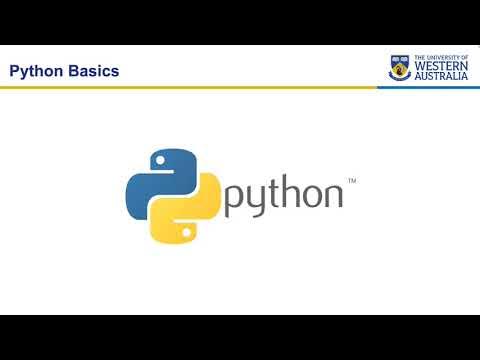Menggunakan Tools Data Science
Summary
TLDRThis video provides a comprehensive introduction to Python programming for data science, covering key tools and techniques. It discusses Python's versatility and beginner-friendly nature, making it ideal for data exploration, preprocessing, cleansing, and modeling. The video introduces essential libraries like NumPy, SciPy, Pandas, and Matplotlib, along with tools like Jupyter Notebook and Google Colab for code execution. It also highlights popular data modeling tools such as Scikit-learn and Orange. With clear explanations, the video serves as a valuable resource for those starting their data science journey.
Takeaways
- 😀 Python is a beginner-friendly programming language widely used for data science projects due to its maturity and ease of use.
- 😀 Python's four primary functions in data science projects are data exploration, preprocessing, cleansing, and modeling.
- 😀 Data exploration in Python includes tasks like data mining and scripting to analyze data patterns.
- 😀 Data preprocessing involves feature selection, descriptive statistics, data visualization, and feature transformation.
- 😀 Data cleansing addresses tasks like handling missing values, removing duplicates, and formatting data, including outliers.
- 😀 Data modeling in Python covers machine learning algorithms for classification, regression, prediction, and clarification.
- 😀 Python code can be executed in two modes: interactive mode (line-by-line execution) and script mode (whole code execution).
- 😀 Jupyter Notebook is recommended for beginners to execute Python code, offering an interactive environment for coding and analysis.
- 😀 Google Colab, a cloud-based platform, offers high specifications and features for Python programming with collaborative options.
- 😀 Essential Python libraries for data science include NumPy (numerical computation), Pandas (data structuring and analysis), and Matplotlib (data visualization).
- 😀 For data modeling, libraries like Scikit-learn provide machine learning tools for classification, clustering, and model selection, while Orange is a user-friendly, code-free tool for data analysis and visualization.
Q & A
What are the key functions of Python in data science projects?
-The key functions of Python in data science projects include data exploration, data preprocessing, data cleansing, and data modeling. These functions encompass tasks like scripting, data mining, feature selection, descriptive statistics, data visualization, and applying machine learning algorithms.
Why is Python considered an ideal programming language for beginners?
-Python is considered ideal for beginners due to its simplicity, readability, and versatility. It has a gentle learning curve, making it easier for new programmers to get started while also being powerful enough for advanced data science projects.
What are the two main modes of executing Python code?
-The two main modes of executing Python code are interactive mode and script mode. Interactive mode allows for running code line by line to see immediate results, while script mode executes a set of code as a whole to produce the final results.
What is the difference between Jupyter Notebook and Google Colab?
-Jupyter Notebook is an open-source web application used for creating and sharing documents containing live code, equations, and visualizations. Google Colab, on the other hand, is a cloud-based platform by Google that allows for collaborative Python coding with the added benefit of high computational power.
What is the purpose of NumPy in data science?
-NumPy is a library used for numerical computations in Python. It provides support for large, multi-dimensional arrays and matrices, along with a collection of mathematical functions to operate on these arrays, making it fundamental in data processing and scientific computing.
How does Pandas help in data analysis?
-Pandas is a powerful library for data analysis that provides two main data structures: Series (1D) and DataFrame (2D). It helps with tasks such as data cleaning, reshaping, joining, merging, and time series analysis, making it essential for structuring and processing data.
What types of data visualizations can be created using Matplotlib?
-Matplotlib is used to create a variety of 2D visualizations, including histograms, bar charts, line charts, pie charts, and scatter plots. It offers flexibility in creating static, animated, and interactive visualizations to understand complex data.
What is the role of Seaborn in data visualization?
-Seaborn is built on top of Matplotlib and provides a higher-level interface for creating attractive and informative visualizations. It offers a variety of charts with more advanced color schemes and statistical representations, making it easier to visualize complex data.
What types of machine learning tasks can Scikit-learn handle?
-Scikit-learn is a library used for machine learning tasks such as classification, regression, clustering, dimension reduction, and model selection. It includes various algorithms like support vector machines, decision trees, random forests, and k-nearest neighbors.
What are the benefits of using Orange for data modeling?
-Orange is an open-source data analysis tool that allows both beginners and advanced users to perform data analysis without coding. It offers a visual workflow for creating data models and provides interactive visualizations, making it easy to understand complex data without writing extensive code.
Outlines

このセクションは有料ユーザー限定です。 アクセスするには、アップグレードをお願いします。
今すぐアップグレードMindmap

このセクションは有料ユーザー限定です。 アクセスするには、アップグレードをお願いします。
今すぐアップグレードKeywords

このセクションは有料ユーザー限定です。 アクセスするには、アップグレードをお願いします。
今すぐアップグレードHighlights

このセクションは有料ユーザー限定です。 アクセスするには、アップグレードをお願いします。
今すぐアップグレードTranscripts

このセクションは有料ユーザー限定です。 アクセスするには、アップグレードをお願いします。
今すぐアップグレード関連動画をさらに表示

All Python Syntax in 25 Minutes – Tutorial

Statistika 06 | Visualisasi Data dalam Statistika | Data Visualization | Belajar Statistika

The Complete Data Science Roadmap (Get Hired in 2025)

Introduction to Python

Natural Language Processing (Part 1): Introduction to NLP & Data Science

UWA CSSE Core Python Programming - Python Basics
5.0 / 5 (0 votes)
